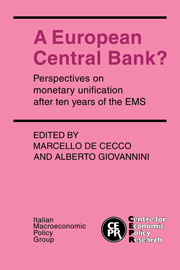Book contents
- Frontmatter
- Contents
- List of figures
- List of tables
- Preface
- List of conference participants
- 1 Does Europe need its own central bank?
- 2 Monetary policy, capital controls and seigniorage in an open economy
- 3 Seigniorage in Europe
- 4 Factor mobility, uncertainty and exchange rate regimes
- 5 Management of a common currency
- 6 The tastes of European central bankers
- 7 The costs and benefits of a European currency
- 8 The monetary unification process in nineteenth-century Germany: relevance and lessons for Europe today
- 9 The establishment of a central bank: Italy in the nineteenth century
- 10 The founding of the Fed and the destabilization of the post-1914 US economy
- 11 Panel discussion on the prospects for a European Central Bank
- Index
9 - The establishment of a central bank: Italy in the nineteenth century
Published online by Cambridge University Press: 05 February 2012
- Frontmatter
- Contents
- List of figures
- List of tables
- Preface
- List of conference participants
- 1 Does Europe need its own central bank?
- 2 Monetary policy, capital controls and seigniorage in an open economy
- 3 Seigniorage in Europe
- 4 Factor mobility, uncertainty and exchange rate regimes
- 5 Management of a common currency
- 6 The tastes of European central bankers
- 7 The costs and benefits of a European currency
- 8 The monetary unification process in nineteenth-century Germany: relevance and lessons for Europe today
- 9 The establishment of a central bank: Italy in the nineteenth century
- 10 The founding of the Fed and the destabilization of the post-1914 US economy
- 11 Panel discussion on the prospects for a European Central Bank
- Index
Summary
Formulating and implementing a common monetary policy: technical problems and political will
Two issues present themselves when discussing the creation of monetary union: firstly, the impact of a common monetary policy on the various economic systems and how far differences in the economic systems should be taken into account when designing a common policy; and secondly, how to solve the institutional problems connected with the implementation of a common monetary policy and what kind of relationship can be established with existing institutions, namely, in the case of European monetary union, the national central banks. In both respects Italian economic history is an interesting case, firstly because at the time of national unity there were marked differences in the political, administrative and economic systems of the States involved – some scholars talked of a sort of ‘mutual extraneousness’ (Cafagna, 1965); secondly, because no State had yet completed its process of industrialization, thus offering an excellent opportunity to study the interrelationships between political unification, market integration and economic growth.
With specific reference to the institutional problems of monetary integration, there are some analogies between Italy at the time of unification and Europe today, since the choice faced by Italian policy makers was not between a note-issuing monopoly and free banking – the term Vera Smith used to describe ‘a regime where note-issuing banks are allowed to set up in the same way as any other type of business enterprise, so long as they comply with the general company law’ (Smith, 1936, pp. 148–49).
- Type
- Chapter
- Information
- A European Central Bank?Perspectives on Monetary Unification after Ten Years of the EMS, pp. 244 - 289Publisher: Cambridge University PressPrint publication year: 1989
- 6
- Cited by

